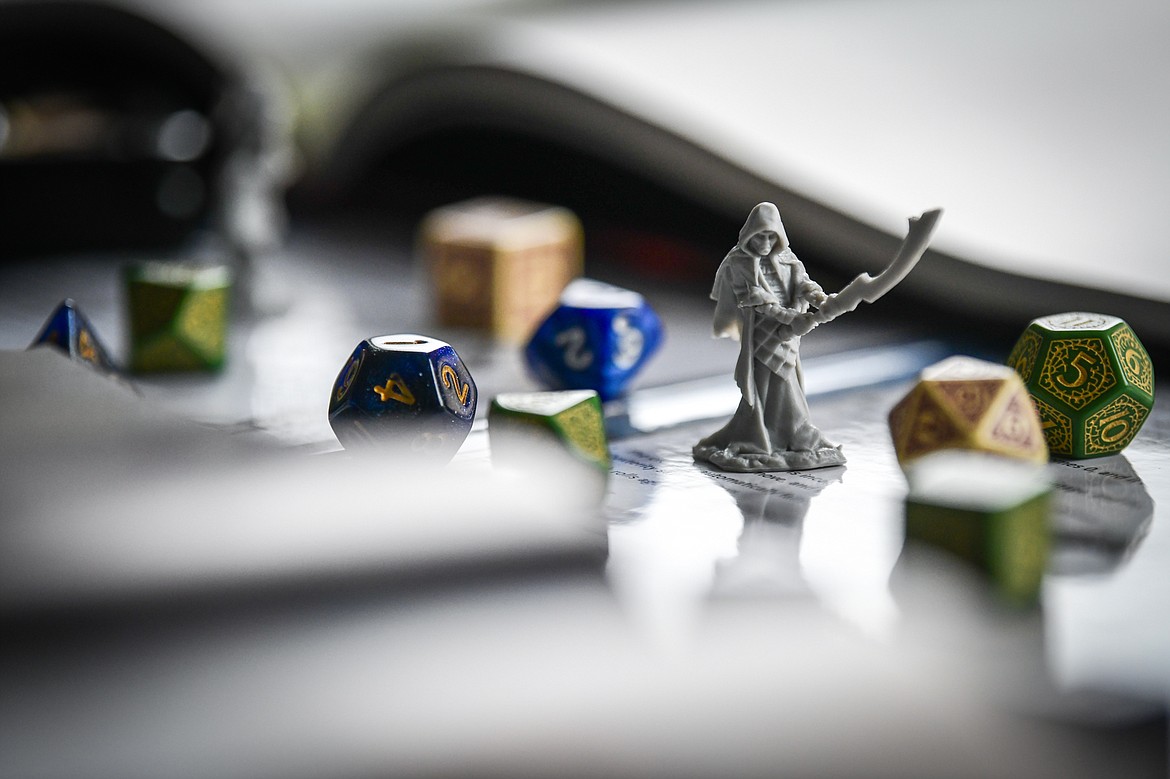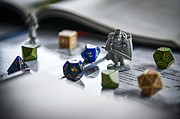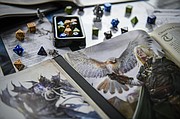FVCC taps into role-playing game’s popularity with continuing education class
Sevrn gazed menacingly upon his adversaries, a trio of ragged looking bandits, one of them clutching the stolen purse the rogue and his compatriots were tasked with recovering. Quivering in anticipation of first blood, Sevrn drew his short bow and loosed an arrow, watching it strike home with satisfaction.
Across the field of battle, Svern’s barbarian comrade nearly simultaneously launched a javelin at another of the bandits. Flying true, it came to a rest deep in the footpad’s shoulder.
Svern glanced with excitement as the final member of his party, a mighty paladin, strode forward.
But, before he can finish off the thieves, a voice breaks in.
“So let me know if I can’t do this. I’m going to play the good cop here and offer to let them turn themselves in before we beat the ever loving crap out of them.”
Jarret Isles, serving as dungeon master as well as instructor of all things Dungeons & Dragons, pauses for just a second and considers the player’s request. He calls for a persuasion check. A plastic 20-sided die clacks and clatters around the table in the Flathead Valley Community College classroom.
“Now from a dungeon master standpoint I’ve got to think as them, so one just took a javelin and is nearly dead and the other one got shot and is at half health, so they might not be too high on morale right now,” he says while the result is tallied.
It works out to 11, a roll of eight with three added on owing to the paladin’s persuasion modifier. It’s not a high roll, but Isles is thoughtful.
“Perhaps it's more to do with how hurt they got immediately. The one with the purse will throw it and book it,” he says his students break into laughter. “The guy who is nearly dead will probably just look at you and [ask] ‘Do you have anything to stop the bleeding?’”
The combat scenario served as the climax to Isles’ six-week beginner course on the famously once-maligned role-playing game, offered this spring as part of the community college’s continuing education program. For two hours each Wednesday, a group of about 10 students worked over the finer points of character classes, ability scores, equipment selection and backstories in preparation for taking their characters on one or dozens of adventures.
A cooperative storytelling game, Dungeons & Dragons lets a group of players act as their characters as they complete quests, slay monsters, solve puzzles and, occasionally, save a fictional world. Under the watchful gaze of a dungeon master, who typically crafts the story, enforces the rules and acts as every other character or monster in the game world, players improve their characters’ abilities, collect treasure and breathe life into the sheet of statistics and equipment that represent their characters.
While props, maps and miniatures can figure into gameplay, much of it is done with imagination and through description and dialogue.
WHILE IT was Isles’ first time teaching in a classroom, he is an old hand at bringing prospective players up to speed on the game. There are various ways to end up spelunking in treacherous cave networks or diving headlong into dungeons bristling with traps and ghouls, but most roads eventually lead to the “Player’s Handbook,” one of three core rulebooks published by Wizards of the Coast, a Hasbro subsidiary. (The company also publishes a starter kit, complete with a precrafted campaign, and makes the basic rules available online as a free download.)
The more than 300-page hardcover is teeming with stats, lore, art and game mechanics. And while its authors repeatedly stress that the rules are more, well, guidelines than anything else, it still can seem overwhelming.
“It was really tough to get into, that’s why I started the class,” Isles said not long after that final session in March.
Isles’ earliest memories of Dungeons & Dragons involve playing with his brothers, basing the campaigns on cover art, making up the rules as they went and using six-sided dice scavenged from Monopoly and Risk. His brother-in-law brought the game back into his life as he entered high school.
Tagging along, Isles came to realize that they were playing using a form of house rules. That led him to try and learn the most current rules as outlined in the fifth edition of the game. The ultimately quixotic effort took him through Discord servers, official websites, message boards and social media platforms, he said. The rules are open to interpretation and everyone, including Wizards of the Coast, has their own understanding of how they work.
Along the way, though, he ended up running his first campaign and teaching other would-be adventurers how to get started.
He eventually compiled his own version of a guide in a spiral notebook. It contained “what, as a new player, I was trying to learn myself playing in someone’s house,” Isles said. “There are so many different rule sets and there’s no wrong way to play it.”
“Going into D&D, I was somehow thinking I need to know all the rules,” he added. “If I had someone say [the rulebooks were] just a guide it would have been a whole lot better for me.”
THAT SPIRAL notebook later served as the basis for his curriculum, which he successfully pitched to the college. Luke Lavin, director of continuing education, said classes are a combination of ideas generated from the community and faculty members offering their expertise to a wider audience.
To his knowledge, Isles’ beginner class is the first Dungeons & Dragons related course the college has offered.
“I’ve wanted to play it for a long time,” Lavin admitted. “I have friends who have. It’s coming back.”
The seemingly sudden popularity of the game is a core tenant of nearly everything written about Dungeons & Dragons in recent years. The plot is nearly always the same: Born in the 1970s, the role-playing game became the scourge of parents during the Satanic Panic of the 1980s before being relegated to nerd culture, emerging from basements and garages into wider culture just recently.
“... Dungeons and Dragons is resurgent,” The New York Times declared in 2019. In 2022, it had moved “beyond nerd culture,” according to the newspaper of record. A search of The Washington Post brings up similar headlines. “The role-playing game is popular again,” USA Today reported in 2020.
“It’s like when you buy a new car,” Lavin said. “You see that car everywhere.”
Everywhere — to even a casual observer — includes references on TV shows, the most oft-cited being in Netflix’s hit series “Stranger Things,” a plethora of podcasts, including the popular “Critical Role,” wherein voice actors strap in as players, and a well-reviewed feature film starring Chris Pine that landed in theaters not long after Isles’ wrapped up his class.
Isles noted that the days of borrowing dice from other game sets are long gone: “Every place has dice for it.”
The streamlined rules for the game’s fifth edition, which came out in 2012 and focus more on the cooperative storytelling elements, are often cited as the catalyst for Dungeons & Dragons’ rise.
Isles also pointed to the ease with which a group of people can get together and play. There’s no logistics beyond a character sheet, the right set of die and a plethora of snacks.
“I wanted people to come in and want to connect … face-to-face, just interacting more with friends and family,” Isles said of his class. “It’s a connection people have lost a little bit.”
THINKING ALONG those lines led Erik Ploot, a podiatrist when not adventuring as a barbarian, into Isles’ classroom. He saw Dungeons & Dragons as a way to spend time with his adult children, all of them “Lord of the Rings” fans, he said.
“I know they would totally get into it,” Ploot said after an early session.
Although he played in high school and middle school and dabbled in college, it’s been a while, he admitted. He heard about the class from his wife and it seemed a way to ease back into it, Ploot said. Both she and his children have been encouraging, he said.
“I’m glad she did, otherwise it’s so hard to even think about jumping into a game,” he said.
Isles’ early sessions ran through the basics of races — elves, gnomes, humans and halflings, among others — and classes, similar to jobs or professions with varying skills, advantages and weaknesses. In a classroom in the community college’s nursing building, his pupils ignored the medical terminology left scrawled on the whiteboards to jot down notes on rogues, bards and monks.
Later sessions focused on the “crunchier” aspects of the game, to use the shorthand of its genre’s aficionados. That meant rolling for ability scores, factoring in bonuses provided by races, and totaling armor classes and hit points. Weapons were chosen and the amount — and type — of damage dealt by a player’s developing character were recorded. Spells were weighed and proficiencies selected.
Isles’ students came from as varied backgrounds as their characters and with as many different motivations for enrolling in the class. At least one had developed their own set of rules for a fantasy role-playing game; others had joined a game and grown frustrated with not understanding the rules.
Student Tori Goins played once prior. The game went fine, she said, but felt her lack of knowledge of the rules presented a barrier.
“I felt a little bit detached because I kept being told what dice to roll, so I couldn’t immerse myself,” she said.
Aside from improving the in-game experience, Isles highlighted various real world applications to the skills developed while adventuring in an imaginary realm. Playing Dungeons & Dragons can help with communication skills and problem-solving abilities in the professional world. That aspect made it into his pitch to the college, he said.
“There are so many aspects in D&D that help people in all facets of life,” Isles said.
There are other classes offered through the college’s continuing education program that offer similar crossover to the business world, Lavin said. An improv comedy class, for example, can help with a variety of skills useful in a professional setting.
“You have to react and think quickly,” Lavin said. “You have to not be afraid to engage. You have to put yourself out there.”
He could have been talking about Dungeons & Dragons.
Isles said his experience participating in and running games has proven beneficial as someone who struggles with public speaking and social anxiety. Without it, he doubted he could stand in front of a classroom.
Even so, launching into the course with 10 sets of eyes staring at him created a certain level of nervousness, he recalled. Thankfully, he had a Dungeons & Dragons character with a background in teaching to draw upon.
“That first session, I kind of went into it as a character,” Isles said with a laugh. “As it progressed, especially with the [students’ engagement], it gave me the confidence to say, ‘OK, I’m good.’”
News Editor Derrick Perkins can be reached at 758-4430 or dperkins@dailyinterlake.com
















